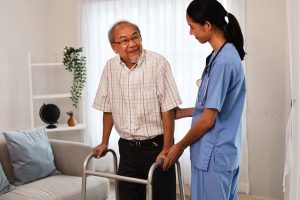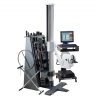
Grip Strength as a Biomarker in Older Adults
Treatment GuidelinesGrip strength is a strong indicator of overall health for older adults. The correlation is so strong between grip strength, overall strength, bodily functions, and aging that it has become a biomarker in clinical settings.
Grip strength is a strong indicator of overall health for older adults. The correlation is so strong between grip strength, overall strength, bodily functions, and aging that it has become a biomarker in clinical settings.
Research shows it is a “reliable, objective and powerful predictor of a multitude of health outcomes”1 and is correlated with fall risk in older adults. In geriatric care, grip strength is “widely adopted as a singular indicator of overall strength”2. This is because it is “sensitive to age-related changes and to changes in biological functioning”3.
Measuring Grip Strength
Measuring grip strength in your assessments provides valuable clinical data. With objective tools, you can track your clients’ progress over time and report numbers they can easily understand.
You can measure grip strength with a dynamometer. Dynamometers are easy to use and affordable and offer the benefits of objective measurement. Measuring grip strength isn’t the only means of assessing wellness, but it is simpler than body systems measurements that may require a referral, special equipment, or lab work.
To learn more about the different types of dynamometers, check out our article, “Strength Testing: Manual Muscle Testing and Dynamometry”.
Grip Strength Changes with Age
Grip strength peaks between age 30 and 40. After age 40, you can expect a decrease in grip strength for your clients. As strength declines, healthcare providers can still evaluate a client’s grip strength to determine how it compares to the normative data for that client’s age group. This will provide data that accounts for an age-related decline.
Grip Strength and Diet
Everyone should follow a balanced diet for overall health. While diet recommendations vary with each individual, protein and hydration are especially important for older adults. Protein helps maintain muscle mass that is vital for joint protection, sarcopenia prevention, and overall health. Proper hydration will aid organ function and maintain energy levels to engage in strengthening exercises. A research study found “strong observational evidence that supports an association between falls and dehydration” for older adults4.
Although you may not be licensed to prescribe dietary changes for your clients, you can discuss general knowledge about nutrition. To learn more about walking this fine line, read this article, “Talking to Patients About Diet: Is Carnivore Truly a Panacea?”
Exercises for Grip Strength
The National Institute of Aging (NIA) divides exercises into four categories: strength, endurance, balance, and flexibility. A comprehensive rehab program will cover all four areas as needed, but here we will cover grip-strengthening exercises.
A functional rehabilitation program incorporating multi-dimensional movements can increase strength, endurance, balance, and flexibility. Facilitating functional exercises in the clinic allows you to provide feedback about safety and body mechanics to prevent injury. Your client may need to perform smaller, isolated strengthening tasks to set a foundation for more complex movements. Early-stage movements include:
- Pushing and pulling
- Throwing
- Gripping and rotating
- Reaching above the head and out to the side
During later-stage sessions, clients can build strength with weightlifting and other resistance exercises. In addition to grip strength, clients can improve endurance with functional activities such as:
- Pulling the grandchildren in a wagon
- Operating a power-washer
- Pushing a lawn mower
- Chopping wood
- Propelling a wheelchair
- Painting a room
Provide quantitative feedback
Providers can use the baseline and interim strength measurements to assess function and health. Numbers are easy for clients to understand and provide motivational goals that keep them engaged. Motivated clients are less likely to miss therapy appointments and are more engaged during the therapeutic process. These clients achieve better outcomes.
Conclusion
Grip strength is an important indicator of general health for older adults. It can be an insightful part of a comprehensive, functional assessment. Grip strength measurement is easy to do in the clinic and can inform your plan of care. With the right tools, you can provide quantitative grip strength data that represents your client’s overall health.
Tasha Perkins Holmes, MOT, OTR/L, BCP
Tasha Perkins Holmes, MOT, OTR/L, BCP is an Occupational Therapist, telehealth expert, and freelance healthcare writer. She creates continuing education courses for allied health professionals in addition to instructing future healthcare professionals. Writing is a means for her to share her knowledge about healthcare topics that are important to healthcare providers and consumers. Writing also provides a way for her to advocate for equitable access to healthcare and increase the public’s healthcare literacy. Feel free to reach out on LinkedIn or Upwork.
References
- Beller J, Miething A, Regidor E, Lostao L, Epping J, Geyer S. Trends in grip strength: Age, period, and cohort effects on grip strength in older adults from Germany, Sweden, and Spain. SSM Popul Health. 2019 Jul 21;9:100456. doi: 10.1016/j.ssmph.2019.100456. PMID: 31453311; PMCID: PMC6700453.
- Bohannon RW. Grip Strength: An Indispensable Biomarker For Older Adults. Clin Interv Aging. 2019 Oct 1;14:1681-1691. doi: 10.2147/CIA.S194543. PMID: 31631989; PMCID: PMC6778477.
- Bohannon RW. Hand-grip dynamometry predicts future outcomes in aging adults. J Geriatr Phys Ther. 2008;31:3–10.
- Hamrick I, Norton D, Birstler J, Chen G, Cruz L, Hanrahan L. Association Between Dehydration and Falls. Mayo Clin Proc Innov Qual Outcomes. 2020 Jun 5;4(3):259-265. doi: 10.1016/j.mayocpiqo.2020.01.003. PMID: 32542217; PMCID: PMC7283563.





